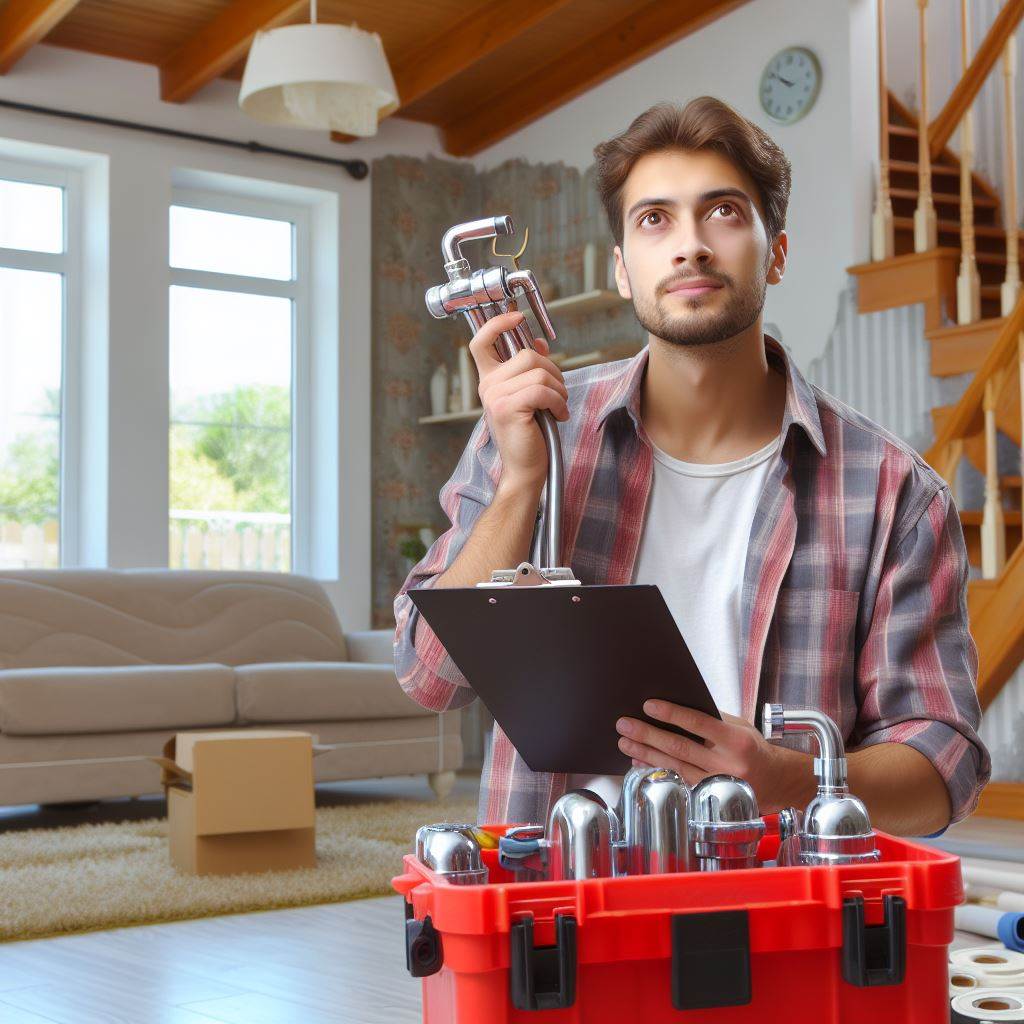Introduction
Plumbing checks play a crucial role in home inspections, as they are essential for ensuring the proper functioning of a home’s water system.
Without thorough inspections, unnoticed plumbing issues can escalate into significant problems, leading to costly repairs and potential damage to the property.
In this blog post, we will delve into the importance of conducting comprehensive plumbing checks during a home inspection.
Overview of what will be covered in the blog post
We’ll provide an overview of the key areas that inspectors should focus on to ensure that all aspects of the plumbing system are in optimal condition.
Firstly, we’ll discuss leak detection techniques. Leaks can occur in various parts of the plumbing system, including pipes, faucets, toilets, and water heaters.
Identifying leaks early on is critical for preventing water damage, mold growth, and increased water bills.
We’ll explore methods for detecting both visible and hidden leaks, such as visual inspections, pressure testing, and thermal imaging.
Secondly, we’ll examine the assessment of water pressure. Proper water pressure is essential for efficient water flow throughout the home.
Low water pressure can indicate underlying issues such as clogged pipes, sediment buildup, or faulty pressure regulators.
Conversely, high water pressure can lead to pipe damage and leaks.
We’ll discuss how inspectors can measure water pressure accurately and what factors they should consider when evaluating it.
Lastly, we’ll address the evaluation of drainage systems. Effective drainage is vital for removing wastewater from sinks, showers, toilets, and appliances.
Poor drainage can result in backups, foul odors, and sewage issues.
During the inspection, inspectors will assess the condition of drainpipes, traps, and vents to ensure proper drainage and ventilation.
We’ll outline common problems to look out for, such as blockages, corrosion, and improper installation, and offer insights into how these issues can be remedied.
By covering these key areas in our plumbing inspection, homeowners can gain valuable insights into the condition of their plumbing system and take proactive measures to address any issues before they escalate.
With a thorough understanding of the importance of plumbing checks in a home inspection and the specific areas to focus on, homeowners can ensure the long-term functionality and integrity of their plumbing system.
Signs of plumbing issues
A proper home inspection is crucial before purchasing a new property as it helps to identify any existing or potential issues that may require attention.
One important area that should be thoroughly inspected is the plumbing system.
Plumbing issues can cause significant damage if not detected and addressed promptly.
In this section, we will discuss some common signs of plumbing issues that may be identified during a home inspection.
Leaking pipes
Leaking pipes are a common plumbing issue that can lead to water damage and mold growth.
During a home inspection, it is important to look for water stains or discoloration on walls or ceilings.
These can indicate an ongoing leak that needs to be addressed. Dampness or mold growth near plumbing fixtures may also indicate a leak.
Additionally, unusual odors from pipes could be a sign of a leak or plumbing problem.
Low water pressure
Low water pressure is another sign of potential plumbing issues.
If the water pressure in the house is consistently low, it may indicate clogged pipes or a malfunctioning pressure regulator.
Low water pressure can affect daily activities such as showering or using appliances that require water.
It is important to address low water pressure issues promptly to avoid further damage.
Slow drains
Slow drains are a common problem that may be identified during a home inspection.
If sinks, showers, or toilets are draining slowly, it could be a sign of clogged pipes or a damaged sewer line.
It is essential to address slow drains as soon as possible to prevent backups and potential water damage.
Ignoring this issue can result in costly repairs down the line.
In essence, a thorough inspection of the plumbing system is essential during a home inspection.
It is important to look out for signs of plumbing issues such as leaking pipes, low water pressure, and slow drains.
Taking prompt action to address these issues can prevent further damage and save homeowners from costly repairs in the future.
Read: Home Inspection: Electrical Must-Checks
Inspecting plumbing fixtures
When conducting a home inspection, it is crucial to thoroughly examine the plumbing system.
Plumbing issues can lead to costly repairs and potential damage to your property.
In this section, we will focus on the key areas that need to be inspected, including faucets, toilets, and sinks and drains.
Faucets
Faucets are an essential plumbing fixture in a home. During your inspection, pay close attention to the following:
- Check for leaks: Examine both the hot and cold water handles as well as the spout for any signs of leakage. Even a small drip can indicate a larger problem.
- Test water flow and pressure: Open the faucets fully and observe if the water flow is steady. Low pressure could be a sign of a clog in the pipes or a problem with the water supply.
- Ensure proper operation of hot and cold water handles: Check if the handles turn easily without sticking and if they accurately control the water temperature.
Toilets
Toilets are another crucial component of a home’s plumbing system. Here’s what you should inspect:
- Check for leaks around the base: Look for any water or moisture near the toilet’s base, as this can indicate a faulty seal or a damaged wax ring.
- Ensure proper flushing and refilling: Flush the toilet and observe if it flushes properly and if the tank refills adequately afterward.
- Inspect water flow and tank mechanisms: Check if the water fills up to the appropriate level and if the flushing mechanism functions correctly.
Sinks and drains
Sinks and drains are critical areas that need proper inspection. Consider the following:
- Look for signs of leaks or blockages: Inspect under the sink for any water stains or moisture that could indicate a leak. Test the drains for any slow drainage or blockages.
- Test water flow and drainage: Turn on the faucet and check if the water flows consistently. Also, fill the sink and observe if it drains properly without any backups.
- Check for proper sealing around fixtures: Ensure that the sinks are securely sealed to the countertops, and there are no gaps or leaks where water can seep through.
In fact, a thorough plumbing inspection is essential when conducting a home inspection.
By carefully examining faucets, toilets, sinks, and drains, you can identify potential issues and address them promptly before they escalate into more significant problems.
Don’t overlook these critical plumbing checks to ensure the overall integrity and functionality of the plumbing system in your home.
Read: Home Buying: Unlocking Powerful Negotiation Skills

Evaluating water heaters
In a comprehensive home inspection, evaluating the water heater is a crucial step. Here’s what you need to look for:
Checking for leaks or corrosion
Start by inspecting the water heater for any signs of leaks or corrosion. Check the surrounding area for puddles, water stains, or rust spots.
Look closely at the water connections for any dripping or moisture. A leaky water heater can lead to significant damage if left unaddressed.
Testing temperature and pressure relief valves
The next step is to test the temperature and pressure relief valves. These valves are essential for maintaining the optimal functioning of the water heater.
Turn off the power supply to the water heater and carefully lift the lever on the valve to release some water. If it fails to open or close properly, it may need to be replaced.
Assessing overall condition and age
Finally, assess the overall condition and age of the water heater. Look for any signs of wear and tear, such as dents, cracks, or loose connections.
Check the manufacturer’s label on the water heater to determine its age. Most water heaters have an average lifespan of 10-15 years. If it’s nearing the end of its lifespan, consider budgeting for a replacement.
If the water heater is older or in poor condition, it may pose safety hazards and could be less efficient, leading to high energy bills.
Remember, a thorough evaluation of the water heater during a home inspection is crucial for ensuring the safety and functionality of your plumbing system.
Read: Home Inspection Insights for First-Time Buyers
Importance of Professional Inspection
A proper home inspection is vital for identifying any potential plumbing issues that may exist within a property.
Hiring a professional inspector with expertise and experience in plumbing can uncover hidden problems that may be costly to repair in the future.
Expertise and Experience in Identifying Hidden Plumbing Problems
While some plumbing issues may be apparent to the untrained eye, many problems can go unnoticed without a thorough inspection.
A professional inspector knows what to look for and has the knowledge to identify potential issues that could cause major problems down the line.
They can identify leaks, worn-out pipes, corroded fittings, faulty valves, and other underlying problems that may not be visible during a casual inspection.
By addressing these issues early on, homeowners can save themselves from costly repairs and inconveniences in the future.
Peace of Mind for Homebuyers
Having a professional inspection done on a property can provide peace of mind to homebuyers.
Knowing that a thorough examination has been conducted, and any potential plumbing issues have been identified, buyers can make informed decisions about their purchase.
Without an inspection, homebuyers may unknowingly inherit plumbing problems that can lead to unexpected expenses and frustrations.
By getting an expert’s opinion, they can negotiate repairs or price adjustments with the sellers before finalizing the purchase.
Potential Negotiation Opportunities for Repairs or Price Adjustments
An inspection report highlighting plumbing issues provides buyers with an opportunity to negotiate repairs or adjustments to the purchasing price.
Armed with evidence of plumbing problems, buyers can request sellers to fix the issues before finalizing the deal.
If the sellers refuse to make the repairs, buyers can use the inspection report to negotiate a reduction in the selling price.
This allows buyers to factor in the cost of future repairs and ensures they are not overpaying for a property with underlying plumbing problems.
Similarly, sellers can also benefit from a professional inspection because it allows them to address any plumbing issues before listing the property.
By fixing these problems in advance, sellers can enhance the value of their home and potentially avoid lengthy negotiations during the selling process.
In summary, a professional inspection is crucial when it comes to assessing the plumbing system of a property.
It provides expertise in identifying hidden problems, offers peace of mind to homebuyers, and creates potential negotiation opportunities for repairs or price adjustments.
Whether you are buying or selling a home, investing in a professional plumbing inspection can save you time, money, and prevent headaches in the future.
By relying on an expert’s opinion, you can make informed decisions and ensure the plumbing in your new home is in excellent condition.
Read: Negotiate Like a Pro: Essential Home Buying Tips
Conclusion
Recap of Plumbing Checks
Plumbing checks in a home inspection are pivotal.
They serve as the cornerstone for ensuring the structural integrity and functionality of one of the most critical systems in any household: plumbing.
Throughout this chapter, we’ve delved into the intricacies of plumbing inspections, highlighting their significance in identifying potential issues before they escalate into costly repairs or disruptions to daily life.
From leaky pipes to faulty fixtures, the comprehensive evaluation of plumbing systems during a home inspection provides invaluable insights into the overall condition of the property.
By scrutinizing water supply lines, drainage systems, water heaters, and other essential components, inspectors can detect hidden flaws that may otherwise go unnoticed.
This proactive approach not only aids in decision-making during the home buying or selling process but also empowers homeowners to address concerns promptly, thereby safeguarding their investment and ensuring a seamless transition into their new abode.
Prioritize Plumbing Inspection
As prospective buyers or sellers, it’s imperative to recognize the pivotal role that plumbing inspections play in the real estate transaction journey.
Rather than relegating plumbing assessments to the periphery of the inspection checklist, we encourage readers to elevate their significance and prioritize them accordingly.
By doing so, you’re not only investing in the longevity and efficiency of your property but also mitigating the risk of potential headaches down the line.
Don’t underestimate the power of a thorough plumbing inspection.
It’s not just about ensuring water flows smoothly; it’s about safeguarding your investment, preserving your peace of mind, and laying the foundation for a home that truly stands the test of time.
So, whether you’re embarking on the exciting adventure of homeownership or preparing to part ways with your current property, remember: when it comes to plumbing, diligence today paves the way for tranquility tomorrow.




